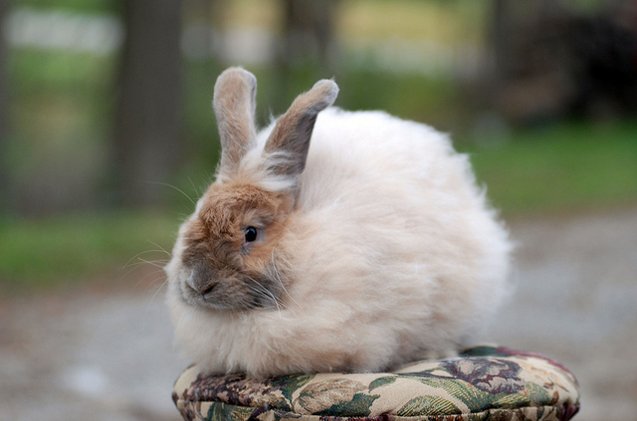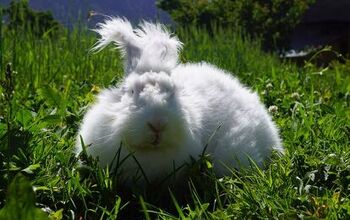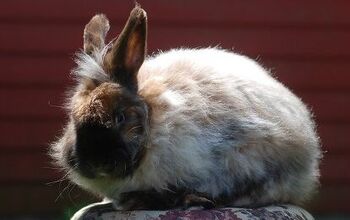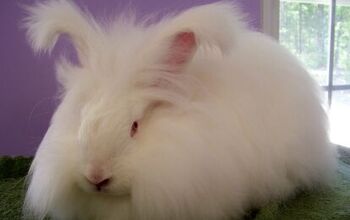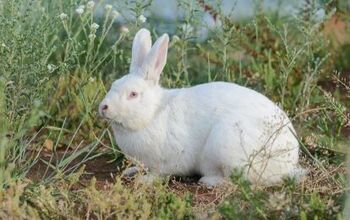French Angora Rabbit


About French Angora Rabbit
Out of all five Angora rabbit breeds (of which four are recognized by the ARBA), the French Angora rabbit is arguably the closest in resembling the “original” Angora that was brought from Ankara (Angora), Turkey in 1723 to France by sailors. The first Angora to set foot in America was called the “Angora Wooler” and there was no differentiation between French, English, Giant, or Satin Angora. It was only in 1944 that the ARBA split these four different kinds of breeds. Today, the French Angora is the second most popular Angora breed (just behind the English).
French Angoras are docile, sweet rabbits who love to hop around freely, whether indoors or out.
The French Angora Rabbit has a commercial-type body and a strong, sturdy frame. Unlike their English counterparts, French Angoras do not have facial furnishings. They can have minor tufting on the rear legs with the rest of their bodies being covered in coarse guard hair and crimped underwool.
While the French Angora rabbit is low maintenance in terms of diet bedding, they do require most attention in the coat department. The French Angora’s coat is called wool, as it can be spun to make articles of clothing. In order to have clean, mat-free wool, you need to clean and tend to their coat. This means regular brushings on an as-needed basis (this may be as often as everyday to as little as once a week), as well as regular blow-dryings to keep their coat separate and clean (since rabbits cannot and should not take baths… this makes them anxious and can cause cardiac problems, sometimes resulting in death). Their coat can grow as much as six inches every season, although the ideal length is about two to three inches. This means rabbit owners need to take the time to shear or trim their French Angora’s wool 3-4 times a year.
The French Angora rabbit has a long list of coat colors and markings. The Pointed White Angoras are pure white in color with markings on the nose, ears, feet and nails. The “Self Group” include blue- and ruby-eyed white rabbits, Black (dark slate wool and brown eyes), Blue (slightly lighter than black coat with blue-grey eyes), Chocolate (light brown wool with brown eyes) and Lilac (pinky, dove-grey wool with blue/gray eyes).
The “Agouti” Group: consists of: Chestnut (wool color is a blend of pearl and blue with brown eyes), Chocolate Agouti (rich brown wool with bands of tan and brown eyes), Copper (roughish red wool with jet black tips, bands of red-orange and brown eyes), Lynx (light tan-colored wool with bands of tan or light lilac and blue/gray eyes), and Opal (primarily blue wool with bands of tan and blue/gray eyes).
The “Chinchilla” varieties of Angoras include Chinchilla (wool is a blend of slate and pearl with alternating bands of pearl and blue/gray with eyes of any shade), Chocolate Chinchilla (brown and pearl-colored wool with bands of pearl/chocolate with eyes any shade of blue/gray, brown or marbled), Lilac Chinchilla (wool is a blend of lilac and pearl, with one or more bands of pearl or lilac with blue/gray eyes) and Squirrel (blue/gray wool with one or more band of similar colors and blue/gray eyes).
There are three more kinds of Angora color listings including the “Shaded Group,” which is Pearl, Sable, Seal, Smoke Pearl, Blue Tortoiseshell, Lilac Tortoiseshell, Chocolate Tortoiseshell and Tortoiseshell. The “Ticked Group” features Blue Steel, Chocolate Steel, Lilac Steel and Steel colors, while the “Wide Band Group” has Cream, Fawn and Red colors with their own distinctive markings.
French Angoras have a long list of coat colors and markings.
Whether you decide to keep your French Angora Rabbit indoors or out, all pet rabbits need plenty of time outside of their enclosures and with their human family to become well-socialized bunnies. This means taking them out of their enclosure to let them roam around freely in your home or outside in your fenced yard where they are protected from other animals and escapes into a neighbor’s yard.
Outdoor rabbits should have sturdy enclosures that are raised from the ground in order to protect them from predators such as raccoons, wolves and coyotes. They should also have a ramp that descends onto the fenced bottom “floor” so they can feel soft grass or ground beneath their feet whenever they please. Indoor rabbits should have plastic enclosures that are large enough for them to easily stretch out their long bodies, and still have plenty of room leftover. Skip wire cages, which are uncomfortable and can hurt your rabbit’s feet in the long run. Opt to have bedding line the bottom of your rabbit’s enclosure – while it does take a little more time to maintain, it will make your bunny happier. Be sure to spot-clean the cage and remove droppings daily and completely replace the bedding every week.
Finally, a rabbit’s diet should consist mostly of good-quality hay (about 70 percent), with the remainder being a balance of fruits, vegetables, pellets and leafy greens. Be sure to talk to your local veterinarian to find out which kind of rabbit food is best for every stage of your bunny’s life, as younger rabbits have a more specific diet than older ones.
Due to their thick, dense fur, French Angoras are most susceptible to wool block. Rabbits are clean creatures and as such, they groom themselves often. Rabbits tend to swallow a small amount of fur every time they groom themselves however unlike cats, they cannot regurgitate their wool. The wool grows and grows inside their bellies, making them feel full or unable to eat. Symptoms of wool block includes a loss of appetite, less droppings and an overall less energetic bunny. Always keep an eye on how much your rabbit is eating and if you suspect your rabbit is experiencing wool block, take them to your local veterinarian immediately.
Like other rabbits, Angoras also are at-risk for overgrown teeth, which can grow into their jaws and face, causing immense pain. A balanced diet consisting mostly of hay should be enough to prevent wool block, as well as overgrown teeth.
Does can be spayed when they are as young as 4 months, however veterinarians tend to wait until the female rabbit is six months old just to be safe – the older they are, the less risk the surgery poses. Bucks can be neutered as young as 3 1/2 months old.
The French Angora rabbit needs plenty of time outside of its enclosure with their human family to become well-socialized bunnies.
The French Angora rabbit was originally bred for two particular uses: meat and wool purposes. However, that isn’t to say that they don’t also make excellent pets so long as they are given plenty of love, attention and affection. Angoras as a whole are docile, sweet rabbits who love to hop around freely, whether indoors or out. The more time they spend socializing out of their enclosures, the friendlier and sweeter they become. Like humans, every rabbit has their own distinct personalities and when they are exposed to humans, their personalities really flourish. They do well with couples who are ready to take the leap into pet parenthood as well as families who have older children who understand how to handle larger animals such as rabbits.
Unlike other pets such as dogs and cats, rabbits are a little bit tricker to litter train. With lots of time, patience and rewards, rabbits can be potty trained but it takes much longer than other pets. Instead of using just one litter box, try to spread a couple around the house so they won’t be tempted to do it in a corner because they cannot hold it in. When rabbit parents find that their bunny tends to do their business where they are not supposed to (such as their favorite corner in the living room), they put a litter box in that particular area and sometimes, that is enough to make the rabbit understand that this is where they need to do the deed.
However, rabbits do enjoy to have some toys like any other animal does, else they may go and gnaw and something they aren’t supposed to, like your brand new shoes. Choose rabbit-safe toys or rabbit-safe blocks of wood to entertain your rabbit and your new heels should get away scott-free.
Photo credit: vjmarisphotos/Flickr

More by Diana Faria



